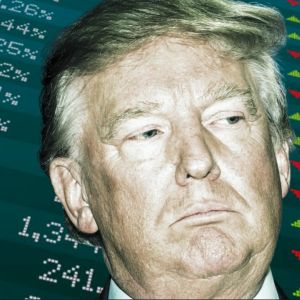In the complex world of global economics and geopolitics, shifts in major trade relationships can send ripples across markets, sometimes even indirectly influencing the sentiment around assets like cryptocurrencies which are sensitive to macroeconomic stability and international tensions. A significant development recently emerged regarding the future of US China trade relations. What Does a Potential US China Trade Deal Mean? Recent comments from U.S. Treasury Secretary Scott Bessent, as reported by Walter Bloomberg on X, suggest a potential turning point in the economic relationship between the United States and China. Bessent indicated that there is a real opportunity for a substantial trade agreement between the two global economic powerhouses. This perspective aligns with the possibility of renewed engagement, particularly under a potential future administration led by Donald Trump, whose previous tenure saw significant changes in trade policy. Bessent’s remarks follow a report from the Wall Street Journal, which highlighted that the Trump administration is reportedly considering a major overhaul of the existing tariff structure on Chinese imports. The potential shift could involve a significant tariff reduction , potentially bringing the rates down into the 50% to 65% range. While still substantial, such a move would represent a notable decrease from current levels on many goods, signaling a potential de-escalation in the trade tensions that have characterized the relationship in recent years. A major trade deal could encompass various aspects beyond just tariffs, potentially including: Intellectual property protection Market access for specific industries Currency manipulation concerns Structural economic reforms The prospect of such a deal suggests a strategic recalibration, potentially prioritizing economic engagement alongside ongoing geopolitical competition. Exploring the Impact of Trump Tariffs The period under President Trump saw the implementation of widespread tariffs on Chinese goods, beginning in 2018. These measures were intended to address what the administration viewed as unfair trade practices, including intellectual property theft, forced technology transfers, and a significant trade deficit. The tariffs covered hundreds of billions of dollars worth of imports, leading to retaliatory tariffs from Beijing. The impact of these Trump tariffs has been a subject of extensive debate. Supporters argued they pressured China to negotiate and protected domestic industries. Critics pointed to increased costs for consumers and businesses, disruptions to supply chains, and negative impacts on American exporters facing Chinese retaliation. The tariffs became a defining feature of US-China trade relations during that era. Understanding the history and effects of these tariffs is crucial when evaluating the significance of a potential reduction. It would not merely be a minor adjustment but a potential unwinding of a major policy initiative that reshaped global trade flows. The Dynamics of Trade Relations Between the Giants The economic relationship between the U.S. and China is arguably the most important bilateral trade relationship in the world. It involves massive flows of goods, services, and capital. However, this relationship is multifaceted and often fraught with tension, balancing deep economic interdependence with strategic competition across various domains, including technology, military influence, and political systems. Key aspects of US-China trade relations include: Interdependence: Both economies are deeply linked through supply chains and markets. Competition: Intense competition exists in key sectors like technology (AI, semiconductors, telecommunications). Structural Issues: Long-standing U.S. concerns include market access in China, subsidies for state-owned enterprises, and regulatory hurdles for foreign companies. Geopolitical Context: Trade policy is often intertwined with broader foreign policy and national security considerations. Any major trade deal would need to navigate this complex landscape, seeking to address economic imbalances while managing strategic rivalries. Bessent’s comments signal a potential willingness to seek areas of cooperation despite these broader tensions. Is Significant Tariff Reduction on the Horizon? The Wall Street Journal report suggests that discussions within a potential Trump administration are considering reducing tariffs to the 50% to 65% range. While details remain sparse, this potential tariff reduction could have several implications: Benefits: Lower import costs for U.S. businesses and consumers, potentially easing inflationary pressures on certain goods. Reduced input costs for manufacturers relying on Chinese components. Potential increase in trade volume between the two countries. Improved sentiment for companies with significant exposure to the Chinese market. Challenges: Potential backlash from domestic industries that benefited from tariff protection. Political hurdles in negotiating a deal that satisfies various stakeholders in both countries. Uncertainty about whether a deal would address fundamental structural issues in China’s economy. Risk of future tariff escalations if the agreement breaks down. The proposed range still represents a significant tariff level compared to pre-2018 rates, suggesting that while a de-escalation is possible, a complete return to previous trade norms may not be the immediate goal. It might be part of a strategy to gain leverage in broader negotiations or a phased approach to trade normalization. Navigating US China Trade Future: Challenges and Opportunities The path forward for US China trade is fraught with both challenges and opportunities. The opportunity lies in finding a stable, predictable framework that allows for mutually beneficial economic exchange while addressing areas of concern. A successful negotiation could unlock significant economic potential for both nations and provide greater certainty for global businesses and markets. However, significant challenges persist. Deep-seated disagreements over technology, human rights, and regional influence complicate economic talks. Domestic political considerations in both countries also play a crucial role, potentially limiting the scope or sustainability of any agreement. Any deal would likely face scrutiny from various interest groups. Actionable Insights for Market Watchers: Monitor Official Statements: Pay close attention to remarks from U.S. and Chinese officials regarding trade talks. Watch Sector Impacts: Identify industries heavily reliant on US-China trade (e.g., technology, agriculture, manufacturing) and assess their potential sensitivity to policy changes. Evaluate Supply Chain Resilience: Companies may continue to diversify supply chains regardless of tariff levels, driven by geopolitical risk concerns. Assess Broader Economic Indicators: Understand how changes in trade policy could influence inflation, growth, and consumer spending. While the focus here is on the potential for a deal, the underlying competition in areas like technology and strategic influence is likely to continue, shaping the context in which economic agreements are pursued. Summary: The prospect of a major US China trade deal , potentially involving significant tariff reduction under a future Trump administration, signals a possible shift in the dynamics of trade relations . U.S. Treasury Secretary Scott Bessent’s comments, coupled with reports of considering lower Trump tariffs , suggest a potential for renewed engagement aimed at finding common ground. While challenges remain, the opportunity for a breakthrough in US China trade talks could have wide-ranging implications for global markets and economies, potentially offering a degree of stability amidst ongoing geopolitical complexities. To learn more about the latest global economic trends and their potential impact on markets, explore our articles on key developments shaping the financial landscape.















